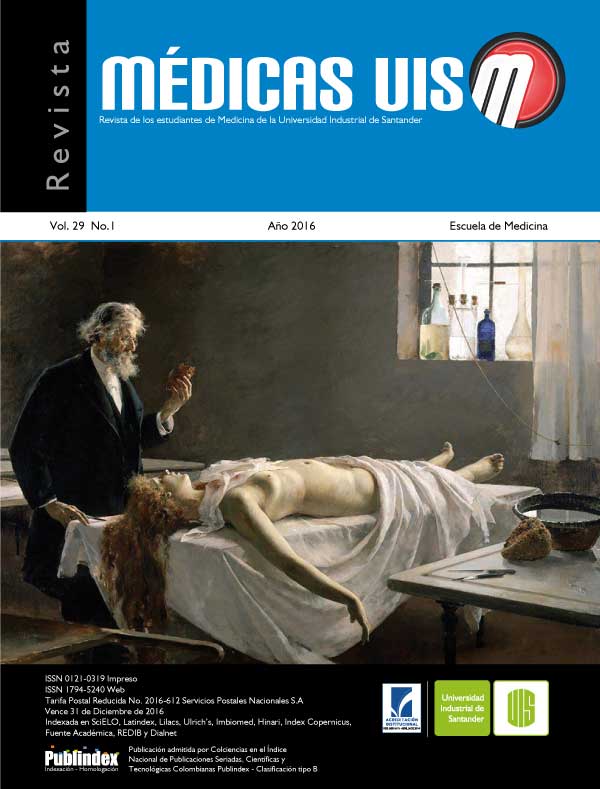Abstract
ABSTRACT
Introduction: the cervical cancer is the second most common malignancy worldwide and the most prevalent of colombian women, the screening with the Pap smear has been a key tool for reducing morbidity and mortality. Objective: to determine the prevalence of squamous intraepithelial lesions, atypical squamous cell and inflammation in women of a municipality of Antioquia,Colombia, and
its association with health system affiliation and area of residence. Methods: a cross sectional study in 2222 women. The prevalence of positive findings and indeterminate for premalignant lesions and inflammation were determined with Bethesda System-2001, it was compared by health system affiliation, area of residence and age through hypothesis testing and prevalence ratios. We analyzed
confounders through multivariate logistic regression. Results: 63.3% live in rural areas, 86.1% are affiliated to the subsidized health system, the prevalence of inflammation was 53.5%, 1.4% of premalignant changes and 3% of undetermined significance results. Conclusion: the prevalence of malignancy was higher in adolescents, rural and subsidized. The study identified the population most at risk for developing cervical cancer in the municipality, relevant information to improve screening and prevention programs. MÉD.UIS. 2016;29(1):29-36.
Keywords: Cervical Intraepithelial Neoplasia. Cervix uteri. Colombia. Prevalence.
References
Dzul K, Puerto M, González M. Cáncer cervicouterino: métodos actuales para su detección. Rev Biomed. 2004;15(4):233-41.
Guerrero M. Neoplasias Malignas. Rev Salud Pública.2000;2(2):173-87.
Burchell A, Winer R, Sanjosé S, Franco E. Epidemiology and transmission dynamics of genital HPV infection. Vaccine.2006;24 Suppl 3:S52-S61.
Bosch F, Muñoz N. The viral etiology of cervical cancer. Virus Res. 2002;89(2):183-90.
Stanley M. Immune responses to human papillomavirus. Vaccine. 2006;24 Suppl 1:S16-S22.
Muñoz N. The global burden of cervical cancer in Latin America and the Caribbean: Perspectives for Prevention. Salud Pública Mex. 2007;49:29-31.
Yang B, Bray F, Parkin D, Sellors J, Zhang Z. Cervical cancer as a priority for prevention in different world regions: An evaluation using years of life lost. Int J Cancer. 2004;109(3):418-24.
Piñeros M, Ferlay J, Murillo R. Cancer incidence estimates at the national and district levels in Colombia. Salud Pública Mex.2006;48(6):455-65.
Gaitán H, Rubio J, Eslava J. Asociación de la citología cervicovaginal inflamatoria con la lesión intraepitelial cervical en pacientes de una clínica de salud sexual y reproductiva en Bogotá,Colombia 1999- 2003. Rev Salud Pública. 2004;6(3):253-69.
Huertas S, Acosta J, Cabarcas M, Sánchez Á, Ricaurte O.Prevalencia de lesión escamosa intraepitelial (LEI) y malignidad para las atipias escamosas de significado indeterminado (ASC-US), en población perteneciente a una aseguradora pública en Colombia, 2004-2005. Rev Colomb Obstet Ginecol.2008;59(2):124-130.
Hernández M, Lazcano E, De Ruiz P, Romieu I. Evaluation of thecervical cáncer screening programme in Mexico: a populationbasedcase control study. Int J Epidemiol. 1998;27(3):370-6.
Tafur L. La salud en el sistema general de seguridad social de Colombia: Régimen Subsidiado. [citado 15 de nov. 2012]. Disponible en: http://66.7.201.232/~saludput/documentos2012/aseguramiento/FUNDAMENTOS_DEL_REGIMEN_SUBSIDIADO_EN_SALUD.pdf.
Alcaldía de Abejorral. Indicadores 2012. [citado 15 de nov. 2012]. Disponible en: http://www.abejorral-antioquia.gov.co/nuestromunicipio.shtml?apc=myxx1-&m=i.
Malik S, Wilkinson E, Drew P, Hardt N. Benign cellular changes in Pap smears. Causes and significance. Acta Cytol. 2001;45(1):5-8.
Departamento Administrativo Nacional de Estadística, Colombia. Censo general 2005. Perfil Abejorral Antioquia. [citado 15 de nov. 2012]. Disponible en: http://www.dane.gov.co/files/censo2005/PERFIL_PDF_CG2005/05002T7T000.PDF.
Sierra C, Acosta M, Orejuela L. Papilomavirus y factores asociados a neoplasia intraepitelial cervical de alto grado en Cauca, Colombia. Rev Salud Pública. 2006; 8(Supl1):47-58.
Sierra C, Tyring S, Au W. Risk contribution of sexual behavior and cigarette smoking to cervical neoplasia. Int J Gynecol Cancer.2003; 13(5):617-25.
Tafurt Y, Acosta C, Sierra C. Prevalencia de citología anormal e infamación y su asociación con factores de riesgo para neoplasias del cuello uterino en el Cauca, Colombia. Rev. salud pública. 2012;14(1):53-66.
Arbalaez M, Grisales H, Vanegas A, Gaviria A, Castaño J, Mora A, et al. Prevalencia de anormalidades de células epiteliales y factores asociados en mujeres de un municipio rural colombiano. Biomédica. 2008; 28(2):271-83.
Flynn K, Rimm D. Diagnosis of ASC-US in women over age 50 is less likely to be associated with dysplasia. Diagn Cytopathol. 2001;24(2):132-6.
Emerson R, Puzanov A, Brunnemer C, Younger C, Cramer H. Long-term follow-up of women with atypical squamous cellsof undetermined significance (ASCUS) Diagn. Cytopathol.2002;27(3):153-7.
Boccardo E, Lepique A, Villa L. The role of inflammation in HPV carcinogenesis. Carcinogenesis. 2010; 31(11):1905-12.
Paler R, Simpson D, Kaye A, Gunn S, Felix J. The relationship of inflammation in the papanicolaou smear to Chlamydia trachomatis infection in a high-risk population. Contraception. 2000; 61(3):231-4.
Franceschi S, Smith J, Van den Brule A, Herrero R, Arslan A, Anh P, et al. Cervical infection with Chlamydia trachomatis and Neisseria gonorrhoeae in women from ten areas in four continents. A cross-sectional study. Sex Transm Dis. 2007;
(8):563-9.
Arora R, Kumar A, Prusty B, Kailash U, Batra S, Das BC. Prevalence of high-risk human papillomavirus (HR-VPH) types 16 and 18 in healthy women with cytologically negative Pap smear. Eur J Obstet Gynecol Reprod Biol. 2005; 121(1):104-9.
Agarwal K, Sharma U, Acharya V. Microbial and cytopathological study of intrauterine contraceptive device users. Indian J Med Sci. 2004;58(9):394-9.
